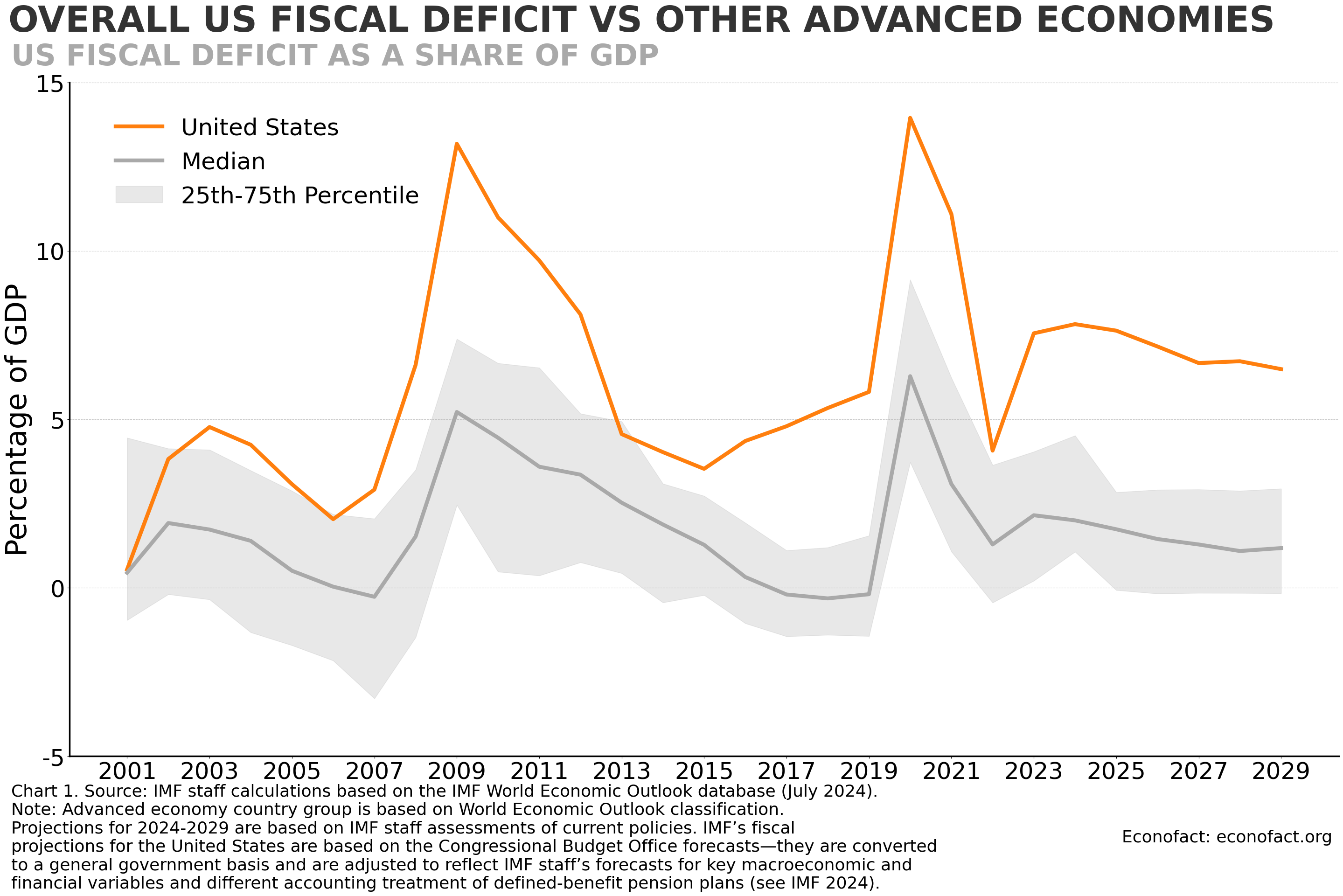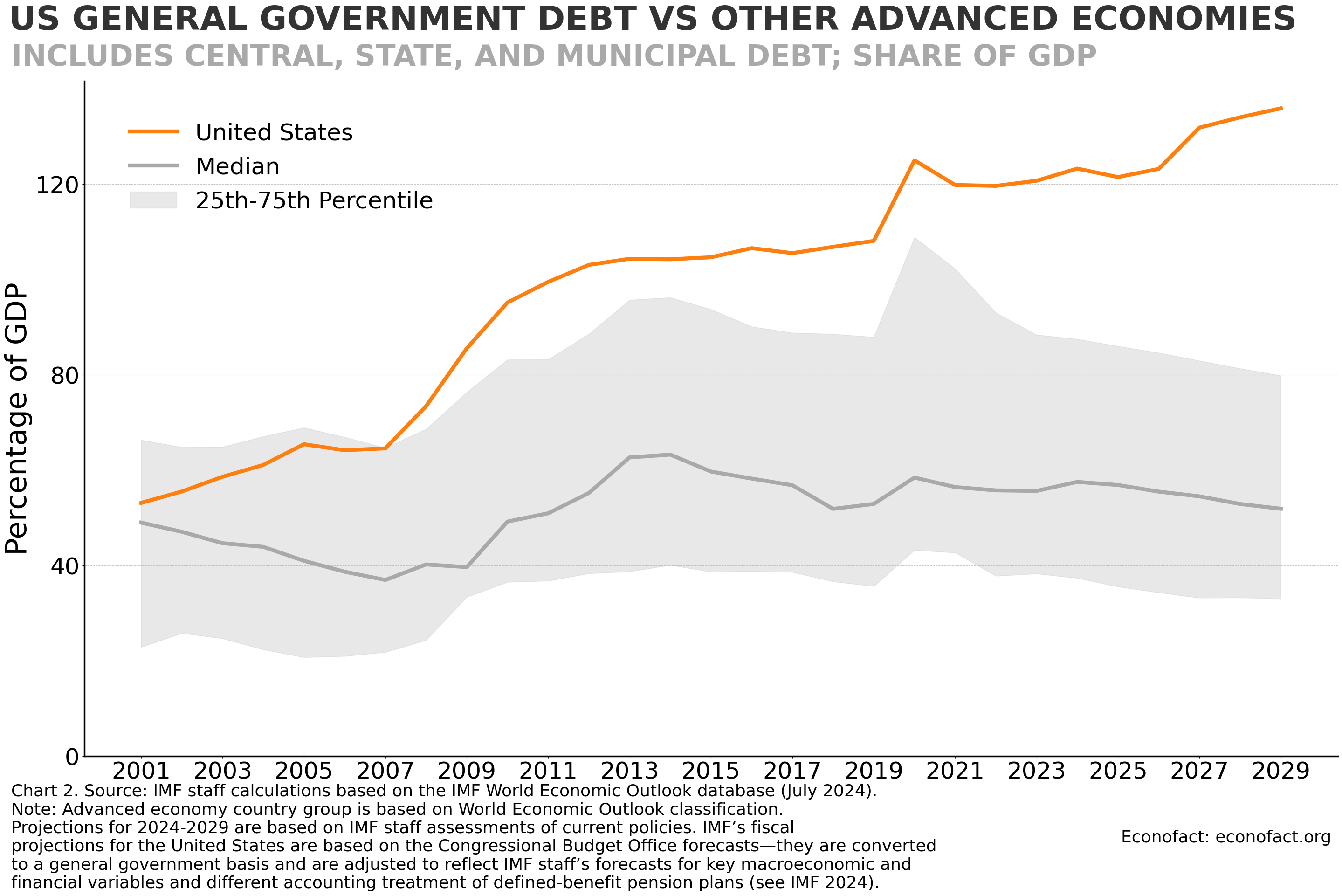The United States’ Fiscal Policy in a Global Context
International Monetary Fund

Click here for a larger version of this graph.
The Issue:
With continued high fiscal deficits likely for the foreseeable future, public debt in the United States is projected to rise faster and reach higher levels than in most other advanced economies. This outlook for large U.S. fiscal deficits and high and rising public debt, especially in the context of high interest rates, raises concerns about the long-term health of the U.S. economy. The prospect has drawn increasing investor attention in bond markets, contributing to increased volatility in U.S. Treasury yields over the past year. This matters greatly for the rest of the world too, since the health of the U.S. economy importantly affects global economic and financial developments, including through spillovers to global financial conditions.
Deteriorating fiscal conditions can have important adverse consequences, raising borrowing costs through the economy and injecting uncertainty.
The Facts:
- The United States’ fiscal position began to deteriorate well before the COVID-19 pandemic. During the years before the pandemic, fiscal deficits narrowed in many advanced economies, albeit moderately. In the United States, however, deficits started to rise in 2016 as some of the fiscal adjustment measures legislated to curb high public debt after the Great Recession either expired or were reversed, and new expansionary measures were put in place—including the Tax Cuts and Jobs Act in 2017. Deficits continued to rise even when the economy was strong in 2018-2019 as revenue losses from tax cuts and increased spending weighed on the budget.
- Under current policies, large fiscal deficits are expected to persist well above levels in most other advanced economies. The general government deficit in the United States jumped abruptly during the pandemic in 2020 but fell in the following two years as the economy recovered. In 2023, however, the deficit rose notably once more to 7.6 percent of GDP, despite robust growth and attendant inflationary pressures (see top chart). The deficit expansion reflected a decline in income tax revenues by about 3 percentage points of GDP from an unusually high level in 2022 as well as increased outlays, including on the new income-driven student debt repayment program, mandatory spending on income security, and higher interest costs. Looking ahead, US fiscal deficits seem likely to stay elevated by international standards, as the political appetite for fiscal correction remains limited. IMF staff projects that the U.S. general government fiscal deficits will gradually settle at around 6 percent by 2029, well above pre-pandemic forecasts over the medium term (IMF 2024).
- Persistently high fiscal deficits imply that U.S. public debt levels are projected to continue to rise, in stark contrast to other advanced economies. The Congressional Budget Office (CBO) projects that federal government debt held by the public will reach 107 percent of GDP by 2029 and 166 percent of GDP by 2054. The IMF projects that US public debt will rise to over 135 percent of GDP by the end of the present decade at the general government level, which includes debt owed by state and local governments (see chart below). In most other advanced economies, incremental fiscal adjustments are projected to stabilize public debt-to-GDP ratios (April 2024 Fiscal Monitor).

Click here for a larger version of this graph.
- An explosive debt trajectory does not necessarily mean looming debt distress risks in the United States. Experience with Japan and other economies has shown that countries that issue their own currency and have credible monetary and financial frameworks are less exposed to the type of debt distress faced by economies relying on foreign currency borrowing. To add to that, the U.S. dollar is the global reserve currency, and the U.S. Treasury market is the deepest and most liquid market in the world (U.S. Inter-Agency Working Group on Treasury Market Surveillance, 2023), providing a so-called ‘exorbitant privilege’ that softens market discipline and allows the country to borrow more easily and cheaply than others.
- Deteriorating fiscal developments can have, nevertheless, important adverse consequences, raising borrowing costs through the economy, and injecting uncertainty. Nominal yields on U.S. 10-year Treasury bonds have risen significantly, reaching 5 percent in October 2023, and remaining relatively high around 4 percent currently even as the post-pandemic surge in inflation eases and the ensuing monetary tightening cycle has begun to unwind. Expansionary fiscal policy in 2023 probably contributed to the extent to which the Fed needed to tighten monetary policy to bring core inflation back under control (April 2024 Fiscal Monitor).
- Yield volatility and nominal term premia (the higher interest rates paid on long-term versus short-term bonds) have also increased markedly on U.S. Treasury bonds since 2022. Although influenced by various factors (including the risk of persistent inflation and uncertainty about the future course of monetary policy), upward revisions to fiscal deficits and a rising supply of government bonds, combined with the Federal Reserve’s continued unwinding of its large holdings of government bonds purchased after the global financial crisis, likely contributed to the increase in bond market volatility and the rise in term premia since mid-2023 (April 2024 Global Financial Stability Report). According to empirical evidence in the April 2024 Fiscal Monitor, a 1 percentage point increase in the US primary balance (the difference between government revenues and expenditures without including interest payments on the debt) is associated with a rise in term premia of about 11 basis points in following quarters.
- High and volatile government bond yields in the United States spill over to the rest of the world through international financial markets. Given the huge scale and central role of U.S. bond markets, large and sudden increases in nominal Treasury yields typically lead to surges in government bond yields in other economies, tightening financial conditions. The increased attractiveness of US assets often feeds into appreciation of the US dollar and heightened exchange rate volatility too (Harikrishnan and others, 2023). The empirical analysis in the April 2024 Fiscal Monitor suggests that a 1 percentage point spike in the US long-term rate is associated with a rise in long-term nominal rates that peaks at 90 basis points in other advanced economies and 100 basis points in emerging market economies. In addition, uncertainty around US future fiscal policies could adversely affect financial conditions and economic activities, through higher sovereign spreads and, thus, borrowing costs, lowering industrial production in other economies (see Hong and others, 2024).
What this Means:
While its dominant position in global financial markets has meant that the United States has been able to run large deficits and sustain high and rising public debt with no evident signs of debt distress, this does not mean that lack of fiscal discipline is cost free. To be sure, the country remains with various policy options to lower its fiscal deficit and avoid its public debt becoming unsustainable. Nevertheless, uncertainties around the fiscal prospects and the current lack of a credible plan to put the public debt-to-GDP ratio on a more sustainable path have negative economic and financial consequences to the United States and to the rest of the world. Achieving the necessary adjustment to put the public debt ratio on a downward path would require significant and politically challenging policy changes. Steps to make discretionary public spending more efficient would help but would not be enough. Sustained deficit reductions will require increasing tax revenues, in a carefully designed approach that would preserve incentives for growth and investment and protect the most vulnerable. Steps could include raising indirect taxes, a progressive shift in income taxes, reducing wasteful tax expenditures, and reforming entitlement programs.
Like what you’re reading? Subscribe to EconoFact Premium for exclusive additional content, and invitations to Q&A’s with leading economists.
